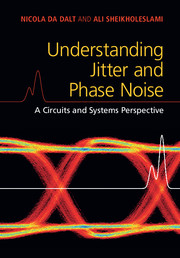Book contents
- Frontmatter
- Dedication
- Contents
- Preface
- Acknowledgments
- 1 Introduction to Jitter
- 2 Basics of Jitter
- 3 Jitter and Phase Noise
- 4 Jitter and Phase Noise in Circuits
- 5 Effects of Jitter in Synchronous Digital Circuits
- 6 Effects of Jitter on Data Converters
- 7 Effects of Jitter in Wireline Applications
- 8 Phase Noise in Wireless Applications
- 9 Advanced Concepts on Jitter and Phase Noise
- 10 Numerical Methods
- Appendix A Review of Random Variables and Processes
- Appendix B Matlab Code for Jitter Generation and Analysis
- Bibliography
- Index
10 - Numerical Methods
Published online by Cambridge University Press: 19 February 2018
- Frontmatter
- Dedication
- Contents
- Preface
- Acknowledgments
- 1 Introduction to Jitter
- 2 Basics of Jitter
- 3 Jitter and Phase Noise
- 4 Jitter and Phase Noise in Circuits
- 5 Effects of Jitter in Synchronous Digital Circuits
- 6 Effects of Jitter on Data Converters
- 7 Effects of Jitter in Wireline Applications
- 8 Phase Noise in Wireless Applications
- 9 Advanced Concepts on Jitter and Phase Noise
- 10 Numerical Methods
- Appendix A Review of Random Variables and Processes
- Appendix B Matlab Code for Jitter Generation and Analysis
- Bibliography
- Index
Summary
The most common approach to the investigation of the behavior of electronic systems in the presence of jitter is to use linear modeling in the frequency domain and phase noise profiles. However, especially in the presence of complex or non-linear systems, it is often beneficial to perform transient simulations and evaluate the results in the time domain. To use this approach, it is necessary to provide numerical methods to, first, generate clock signals in the time domain that have given phase noise profiles and, second, analyze the results of transient simulations and possibly convert them into phase noise plots. The goal of this chapter is to provide some of these techniques.
Most of the chapter is dedicated to algorithms and numerical recipes to generate jitter samples with several different phase noise profiles, and to compute jitter and phase noise given a vector of time instants, typically obtained from transient simulations. Following that, basic algorithms to perform tail fitting are presented. All algorithms are implemented and demonstrated using Matlab and are coded such that they can be easily ported to any other common programming language. The code is included in Appendix B.
Numeric Generation of Jitter with Given Phase Noise Profiles
The problem addressed in this section is how to generate a sequence of numbers tk representing the instants of the edge transitions of a clock having nominal frequency f0 and a desired phase noise profile L(f).
As a starting point, the sequence tk can be decomposed into the sum tk = tid,k + ak of a vector describing an ideal clock, tid,k = k/f0 with k ≥ 0, and a vector ak describing the jitter process. Note that the ak corresponds to the absolute jitter, according to the definition given in Section 2.1.1. The problem translates then into the generation of the sequence ak showing a given phase noise profile L(f).
Before proceeding it is important to recall that the PSD of the sequence ak is independent from its probability density function (PDF). To make it clearer, imagine one realization of the process ak being plotted on a graph, where the x-axis is the index k and the y-axis is the value (amplitude) of ak.
- Type
- Chapter
- Information
- Understanding Jitter and Phase NoiseA Circuits and Systems Perspective, pp. 207 - 219Publisher: Cambridge University PressPrint publication year: 2018



